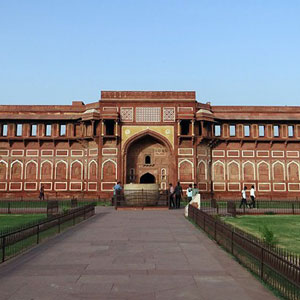What to See
Taj Mahal: Undoubtedly India’s definitive monument, the Taj Mahal needs no introduction. One of the Seven Wonders of the World, it was built by Shah Jahan for his beloved queen Mumtaz Mahal as a labor of love. It is graced by four minarets and a perfect dome, beneath which rests their tombs. It's not just the perfect symmetry in its design, but the exquisite carving covering every inch of the marble that grabs your attention. These intricately carved designs, mostly floral bouquets, are inlaid with precious stones. A peculiar feature - watch the calligraphy adorning the walls. They increase in size as you look up, creating an optical illusion of all letters being the same size. Another astounding feature is the filigree screens that surround the cenotaph carved out of a single piece of marble. It is believed that the Taj changes color depending on what time of the day it is. We recommend visiting it in the wee hours of the morning or in the evening when the sunset renders it an orange hue. The best time, though, is on a full moon night when the entire structure is bathed in a silvery sheen, giving it an ethereal appearance.
*Open from sunrise to sunset, closed on Fridays
Entry fee - Indians Rs 20, foreigners Rs 750;
Cameras: Still cameras free, video Rs 25

Agra Fort: This World Heritage site is located next to the Taj Mahal and is built in red sandstone. A crescent shaped fort, it is surrounded by ramparts of red sandstone and a deep moat on the outer wall. Within the fort are several interesting structures and buildings. Visit the Jahangiri Mahal, which used to house the women of the palace. This palace has a stone pool before it, which was believed to have been filled with rose petals during Noor Jahan’s time. Adjacent to it is the Anguri Bagh and the Khas Mahal, which is another example of Shah Jahan’s designs in white marble. Also located within is the mirrored Sheesh Mahal and Mina Masjid or (Gem Mosque). Adjacent to it is Diwan-i-Khas (Hall of Private Audience), and beyond it is Diwan-i-Am (Hall of Public Audience), where the emperor addressed his subjects' issues.
*Open from 6am-5:30pm; Entry is through Amar Singh Gate only
Entry fee - Indians Rs 20, foreigners Rs 300;
Camera photography free, video Rs 25 Son-et-lumiere (Sound-&-Light show) tickets - Indians Rs 30, foreigners Rs 75;
Timings - English 7.30 pm, Hindi 8.30 pm.
Chini-Ka-Rauza: This Persian style tomb is an impressive masterpiece of glazed style décor and architecture. The Chini-ka-Rauza is covered with coloured enamel tiles, zig-zag patterns in crimson, orange and white, floral designs in blue, green, orange and red and traces of paintings and Islamic calligraphy can also be seen. It is particularly noted for its Persian influenced dome of blue glazed tiles. It is dedicated in memory of Afzal Khan, a Persian poet and Prime Minister in the court of Akbar.
Itmad-ud-Daula: Also known as mini-Taj, this tomb was built by Nur Jahan for her father Mirza Ghiyath Beg, who was given the title 'Itimad-ud-Daula' (Pillar of the State). Constructed in marble, this monument marked a shift in Mughal architecture - from red sandstone to white marble. The entire structure is adorned with delicate motifs and typical Persian paintwork. The walls are encrusted with precious stones in the form of trees, wine bottles, cups and vases. The building also consists of a garden, which is interwoven by water courses and walkways.
*Open from sunrise to sunset;
Entry fee - Indians Rs 15, foreigners Rs 110
Fatehpur Sikri: Built by Emperor Akbar, the now-deserted city of Fatehpur Sikri was the capital of the Mughal Empire for nearly 10 years. Today, a World Heritage site, it houses within it some of the most magnificent buildings. Of particular interest would be the Diwan-i-Am, where the ruler met the public and the Diwan-i-Khas or the Hall of Private Audience, marked by its central pillar and vaulted brackets. The Panch Mahal is a five-storeyed palatial structure and the tallest in the compound. The Jama Masjid is one of the largest mosques in India and has several aisles around a central courtyard. It houses within it the tomb of the Sufi saint, Sheikh Salim Chisti. The Masjid is decorated with inscriptions, geometric patterns and colored tiles. A distinguishing feature - watch the rows of chhatris over the main building. The Buland Darwaza, rising to about 45 ft, was added to commemorate Akbar's victory over Gujarat and is inscribed with splendid calligraphy. Jodha Bai’s Palace is perhaps the grandest of all palaces here with its large courtyard surrounded by pavilions - note its beautiful green glazed roof tiles.
*Open on all days from sunrise to sunset.
Entry fee - Indians: Rs 15; foreigners: Rs 250; Entry free on Fridays
Ram Bagh: The oldest Mughal garden built by Babur, it is located close to the Taj Mahal. It is marked by pathways, canals and cascading water over terraces.
*Open on all days from sunrise to sunset.
Entry fee - Indians: Rs 10; foreigners: Rs 100
Sikandra (Akbar's Tomb): The city of Sikandra houses the tomb of Akbar. Legend has it that the construction and design of the tomb was started by Akbar himself, and subsequently completed by Jehangir. The tomb is made of five storeys, the first four built of red sandstone and the fifth with marble. The tomb also has several well-maintained gardens. *Open on all weekdays from sunrise to sunset. Entry fee - Indians: Rs 10; foreigners: Rs 110
Top Hotels in Agra
- Radisson Blu Hotel Taj East Gate Road Agra
- Itc Mughal
- Four Points By Sheraton Agra
- Jaypee Palace Hotel Convention Centre Agra
- Crystal Retreat
Top Landmarks in Agra
- Hotels Near Bhagwan Talkies
- Hotels Near Tundla Railway Station
- Hotels Near Kamla Nagar Market
- Hotels Near Raja Ki Mandi Railway Station
- Hotels Near Radha Soami Samadhi Dayalbagh






